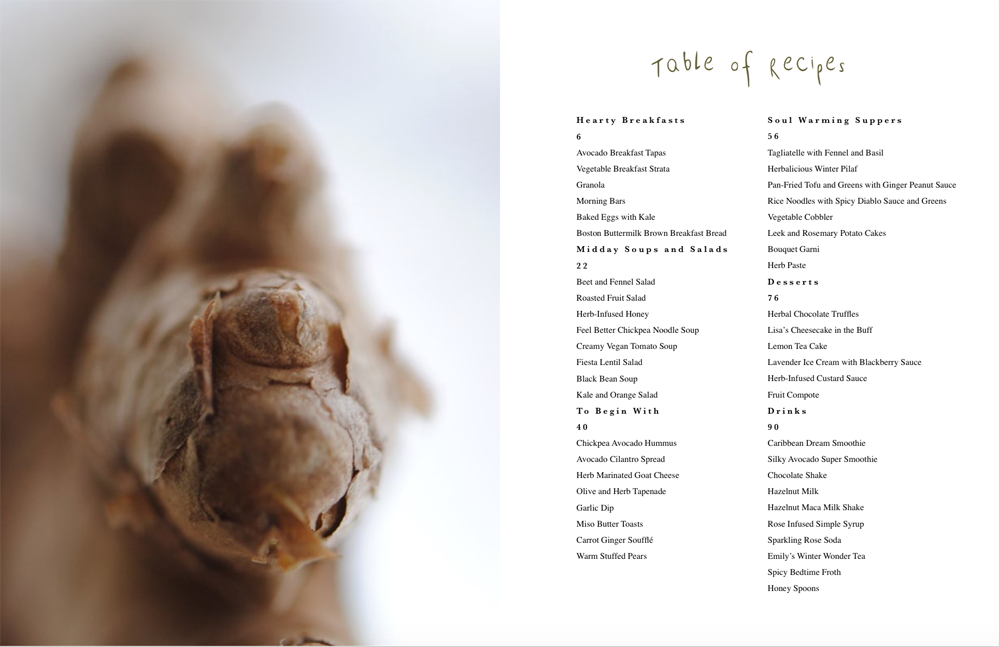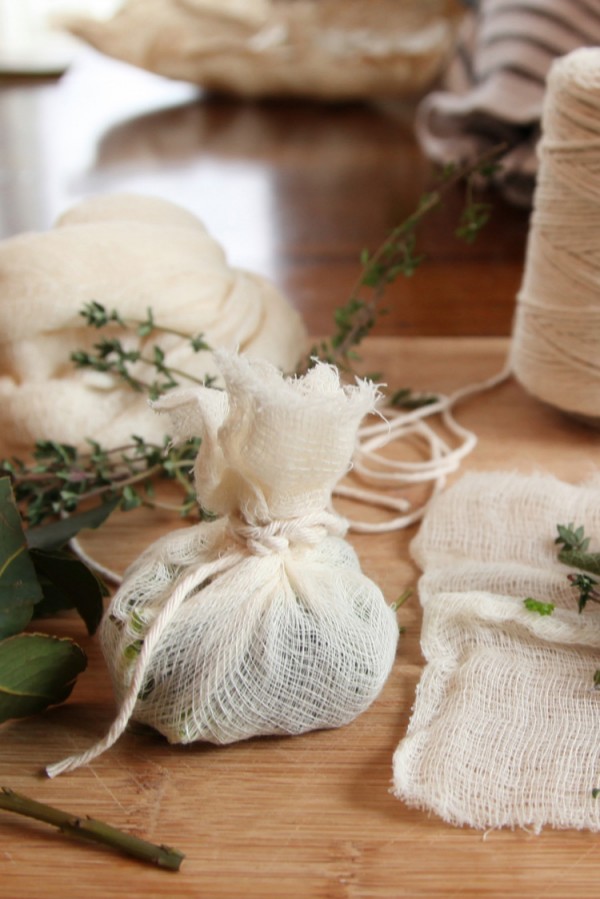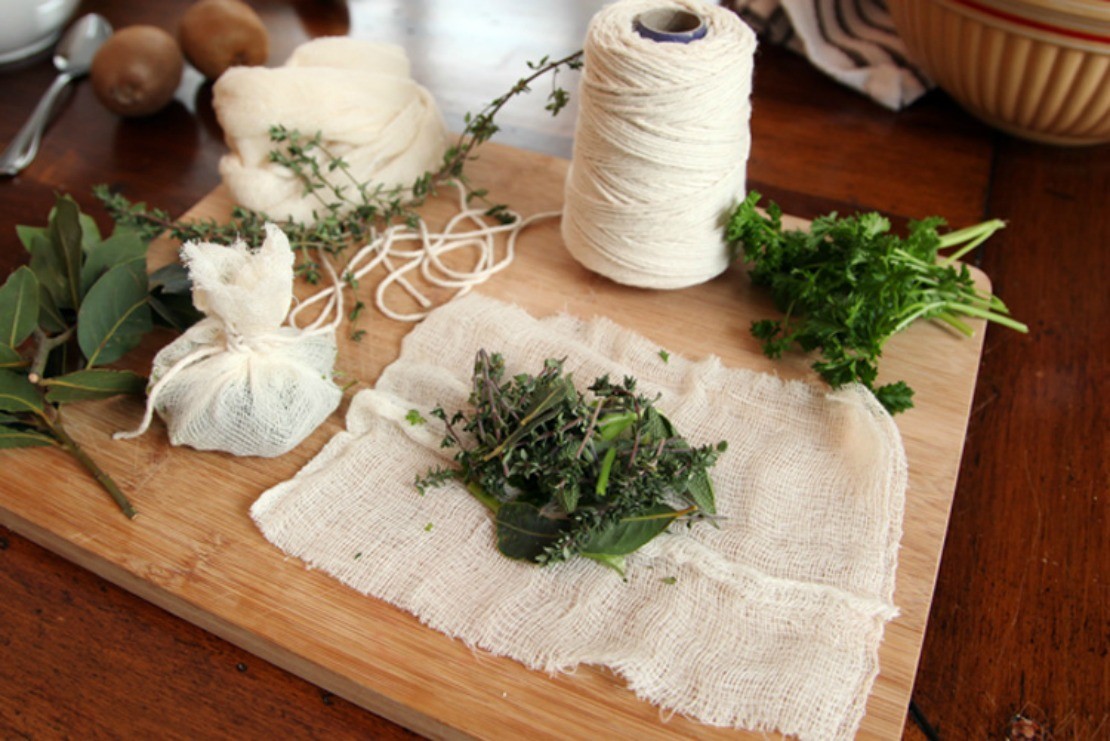
What is Bouquet Garni?
Bouquet garni is a fancy word for a simple, useful concept. It refers to a seasoning bundle of herbs tied together with string or placed inside a square of cheesecloth, with origins in French cuisine as a way to flavor sauces, soups, stews, and other simmering pots. Tying the herbs together is a clever way to allow their wonderful flavors to steep into your cooking while making it easy to remove the herbs when the dish is ready to be served. This is a plus when using fresh herbs that would be difficult to chop or grind finely enough prior to use, or when you have whole, dried herbs at your disposal. Bay’s tough leaves and rosemary’s little needles come to mind — neither are fun to pick around while you are trying to enjoy your dinner. Bouquet garni is an elegant solution that allows you to enjoy the flavors and the health benefits without the hastle!
Directions for making these little herb bundles was featured in The Herbarium’s Cooking with the Seasons Winter Edition ebook. We are delighted to share it with you here and give you even more background on the surprising herbal uses of these common kitchen seasonings. Get a copy of Cooking with the Seasons ebook from our Shop. It is also included with The Herbarium membership!
Bouquet garni can be made using fresh or dried herbs and there are two techniques to choose from. The first one, using fresh herbs, only requires a few sprigs of herbs and some cooking twine. The second option can be used for fresh or dried herbs.
For basic fresh bouquet garni tied with string, follow the directions below:
String-Tied Bouquet Garni
3 sprigs of parsley
2 sprigs of thyme
1 sprig of sage
1 bay leaf
cooking twine
- Place the sprigs of fresh herbs on top of one another, all facing the same direction. This will make it easy to create a tidy little bundle.
- Tie the string around the herbs at the base and wind the twine along the herbs to hold them all together.
- Tie off the string at the other end of the bundle, and you’re all done. If you like, leave a tail attached to make it easy to remove the herbs when your dish is finished cooking.
Feel free to change the amounts of the herbs or to leave one entirely out if you prefer — whatever you think will taste best for the dish you are making. This method works best with fresh herbs, but you can use fresh or dried herbs for the method below.
For basic bouquet garni wrapped in cheesecloth, follow these instructions:
Bouquet Garni Wrapped in Cheesecloth
A pinch of parsley
A pinch of thyme
A pinch of sage
1 bay leaf
1 small square of cheesecloth (approximately 4” square is a good size)
Cooking twine
- Place the desired amounts of each herb in the center of your cheesecloth square. If you are using fresh herbs, use some scissors to snip them into small pieces that will fit inside the finished pouch.
- Pull up the edges around the herbs to create a small pouch with the herbs inside, and tie securely with cooking string. Now it’s ready to be used! Simply add the bag to your meal as it cooks, and remove it before serving.
If you used dried herbs, you can make several bundles at once and store them in a labeled, airtight container to have on hand for later. Again, remember that this recipe is a suggestion and that the herbs can be changed according to your likes or dislikes, or even based on the dish you have in mind. Marjoram, oregano, and rosemary are other herbs you may want to try.
Bouquet Garni Outside of the Kitchen
The individual herbs in bouguet garni are known for their unique flavors and ability to add that extra something to soups and stews. But the benefits don’t stop there — in the hands of a skilled herbalist, the humble kitchen herbs used in bouquet garni are transformed for uses outside of the kitchen.
Thyme
Thymus vulgaris
- anthelmintic
- carminative
- expectorant
Not only does thyme taste wonderful as a culinary herb, it’s also great at helping boost digestion. So perhaps it’s no wonder that it has found its way into so many cuisines and traditional seasoning blends. From Jamaican jerk spice and Egyptian dukka to French bouquet garni or herbes de Provence — this herb plays well with other flavors and really gets around. Herbalists will also tell you that thyme is very beneficial to the upper respiratory tract and features in many traditional cough and cold formulas.
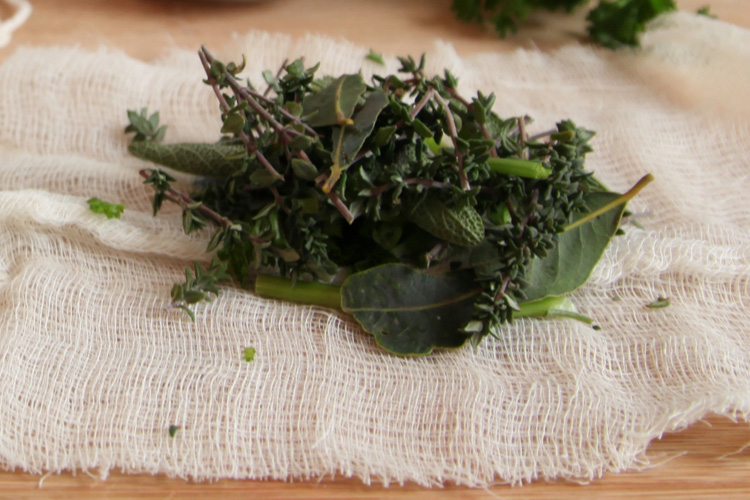
Sage
Salvia officinalis
- astringent
- carminative
- nervine
Because of its astringent properties, herbalists love sage tea as a gargle for sore throats. Traditionally, it has also been used as a nervine for stress and as a carminative for digestive support — but we now know that sage contains a component called thujone, which is harmful if taken in large amounts for extended periods of time. Drying can reduce the thujone content of sage (Phaneuf, 2005), but it should still be avoided during pregnancy in any amount larger than occasionally used for cooking.
Parsley
Petroselinum crispum
- digestive aid
- diuretic
- anti-inflammatory
Parsley is a member of the Umbelliferae family of plants that includes carrots, celery, and fennel. Chewing on a few sprigs of parsley can help freshen the breath after a meal, and the leaves are full of vitamins and minerals that make it a powerhouse garnish on the side of your plate. Tea made from parsley leaves is traditionally used as a diuretic and as a digestive aid.
The leaves of this plant are good for you, but stay away from the seeds and essential oils of parsley. These contain high levels of two naturally occurring toxic chemicals that should be avoided — myristicin and apiole (Phaneuf, 2005). This is a great example of why it’s important to research which parts of a plant are commonly used rather than assuming that if one part is safe to use, the rest of the plant must be as well.

Bay
Laurus nobilis
- anthelmintic
- carminative
- rubefacient
Bay leaf is traditionally used to increase the efficiency of digestion. A cup of bay leaf tea while you rest can be very comforting at the first signs of food poisoning (McBride, 2010). Besides adding flavor, a leaf added to the water while cooking grains and beans can enhance the digestibility of the finished dish. A topical preparation known as Oil of Bays was used for bruises and strains in the early 1900s (Grieve, 1931).
Now that you know how to make these simple little bundles of herbs and some of their many benefits, consider adding your very own bouquet garni to the pot for flavor and health the next time you make soup or stew. Not only will you be honoring an age old tradition, you will also be adding both flavor and extra nutrition to your food.
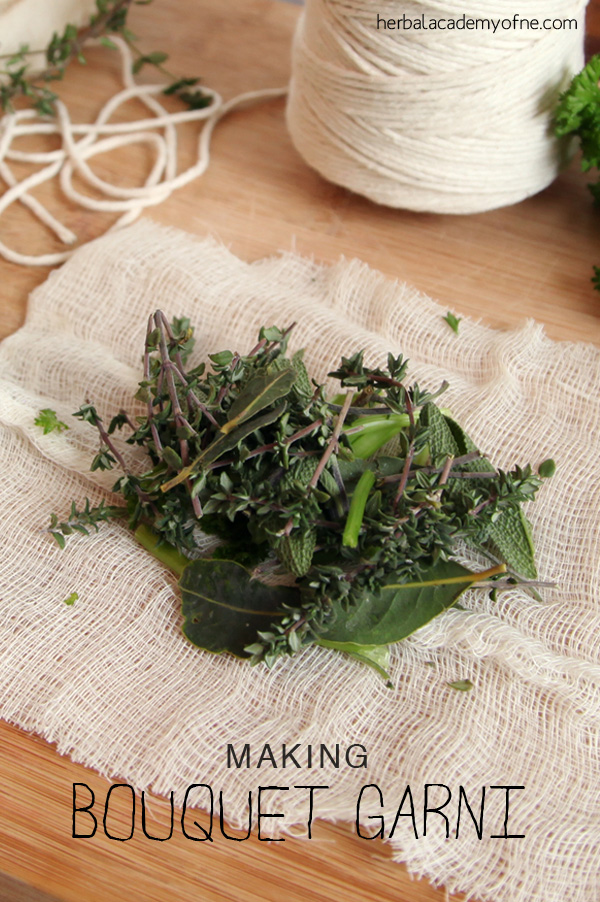
Visit our online courses for more information on learning herbalism and sign up for our weekly digest email so you never miss a post! To get a copy of Cooking with the Seasons Winter ebook, shop here or sign up for our affordable membership program, where all ebooks come free!
REFERNCES
McBride, Kami. (2010) The Herbal Kitchen. San Fransisco: Conari Press
Phaneuf, Holly, PhD. (2005) Herbs Demystified. New York: Marlowe & Company

